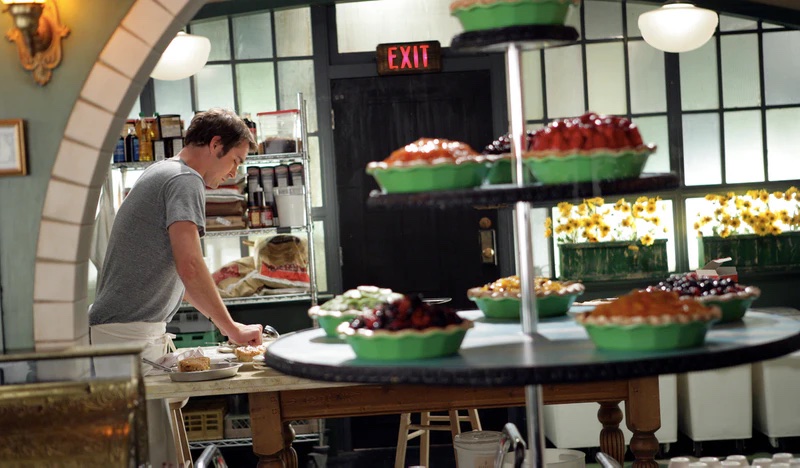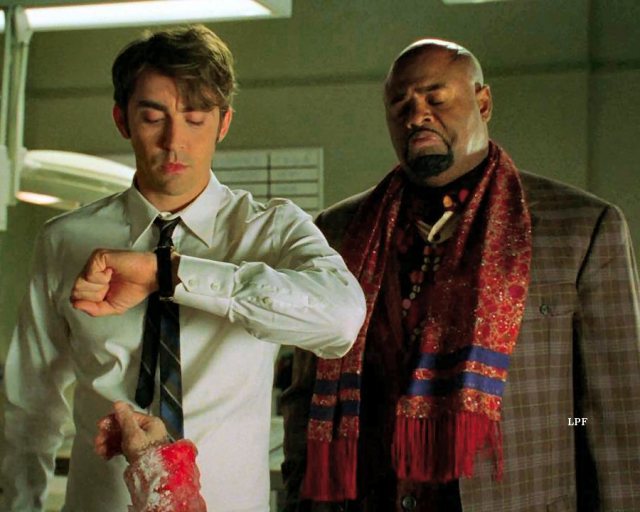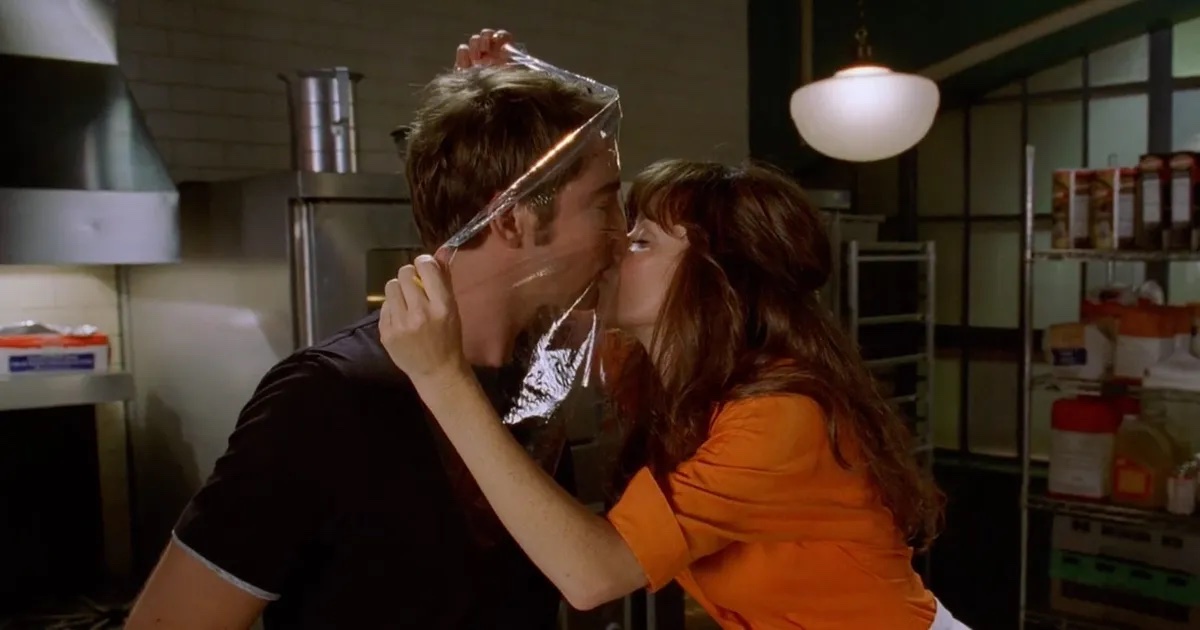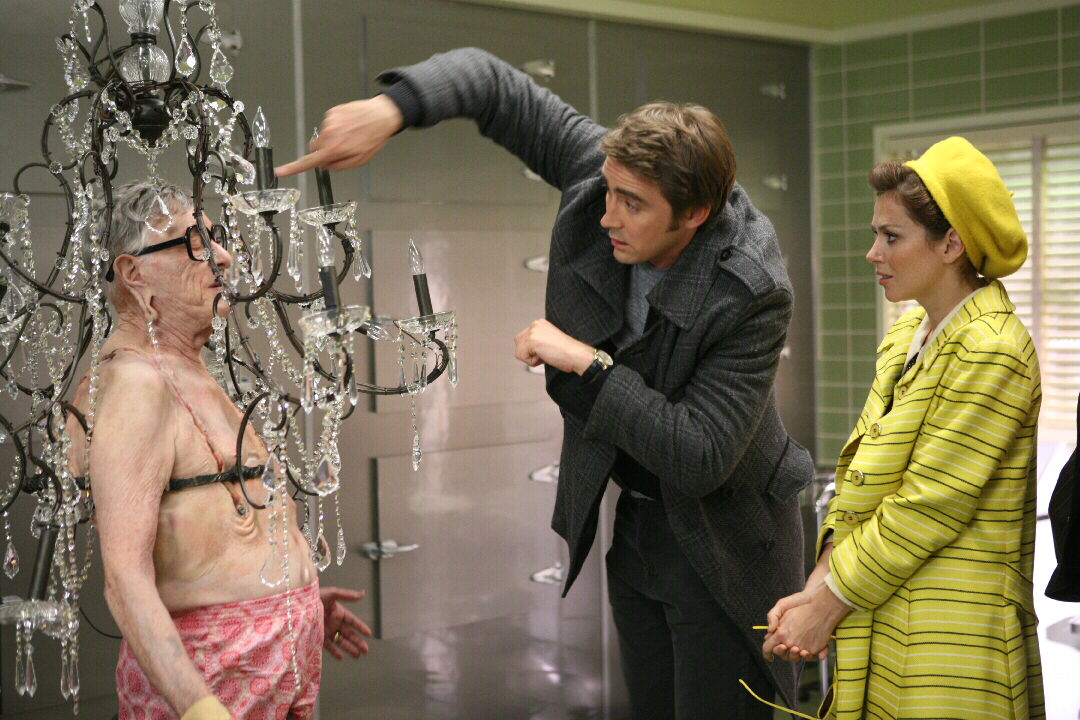This essay, much like its subject, is imbued with the desire to wake the dead. Pushing Daisies, Bryan Fuller’s strange, polychromatic television show about a shy baker whose touch can bring the dead back to life, has been off the air since it was cancelled after its second season in 2009. There have been whispers of revival hopes (both from fans and the cast itself), but still, it remains kind of quiescent in mainstream culture; a series that many loved and seem to remember fondly, but which has not experienced a public afterlife, even despite the increasing notoriety of its lead, Lee Pace. Perhaps this is because it arrived on a streaming platform (HBO Max) only recently; before that, if you wanted to watch Pushing Daisies, you had to hunt down the seasons on DVD, like I did. I don’t know. I do know, though, that we are gathered here today to honor Pushing Daisies, and I hope that when we do, we will reanimate it a bit. Let us pray.
Pushing Daisies might be most memorable for its bright, uncanny visuals—a merry, surreal palette of greens, reds, and yellows that don’t veritably exist in nature. The candy-colors of Pushing Daisies reflect its deep thematic investment in artificiality—on a tonal level, the show concerns simulacra of life, rather than life itself. Its characters cannot truly live the lives they want, and this is rather literal. Ned (Lee Pace) is a gentle, bashful entrepreneur (the proprietor and chef of a pie bakery called “The Pie Hole”) guarding a disquieting secret—he has the ability to bring dead things back to life with only a touch. But if he lets these newly animated entities live for longer than a minute or so, another entity of equal mass must die in its place, to restore the balance of the universe. Touching them a second time will return them to death, permanently—which means that if he wants to reconnect with anyone after they have passed, he only has a solitary minute to do so.
But Ned’s sad gift also makes him a danger to those around him: resurrecting a dead entity can endanger those living around him if he can’t touch the body again in the right amount of time. If he chooses to risk keeping someone alive after a minute, he can never touch them again, lest they die forever. Flashbacks to his childhood stress the trauma of his discovery of this gift; as a child, he saves his mother after she dies of natural causes, thereby killing the father of the little girl who lives across the street. And then he accidentally kills his mother when she tries to kiss him goodnight. After he resurrects his childhood dog following a car accident, he realizes he can never pet or cuddle his friend again (for the rest of the dog’s life, he must use a wooden mannequin arm to scratch his head). Ned’s history of trying to save those he loves results, for him, in a lifetime of reservedness and even isolation.
Ned spends the rest of his life so far in a kind of half-life; not getting too close to anyone, much to the consternation of his lovelorn employee, the waitress Olive Snook (a perfectly squeaky, Emmy-winning Kristen Chenoweth). The only people he touches are—get this— deceased murder victims. That’s because his only friend (besides the dog he can’t touch and the waitress he doesn’t want to) is local private investigator Emerson Cod (a wonderful Chi McBride), who gives him a cut of reward money for his help in solving mysterious deaths. Emerson is the only one who knows Ned’s secret and he’s all too happy to guard it, since it turns quite a profit; turns out, mysterious deaths are easier to solve when you can wake murder victims and ask them how they died. Thus, Ned, with his strange life-giving abilities, is surrounded all the time by dead bodies waiting to be given a final minute of life, and live bodies seemingly waiting to die.
That is, until his childhood crush—the little girl who had lived across the street during his childhood—comes back into his life. When she dies. The perky, indefatigable Charlotte Charles, or as she is known to Ned, “Chuck” (Anna Friel), is murdered at the age of twenty-eight while aboard a cruise ship. When Ned is called by Emerson to help solve her murder, and wakes her from her eternal slumber, he discovers that he doesn’t have the heart to kill her again. His feelings for her return. And so he leaves her alive. This has dangerous consequences. And, inconveniently, as they fall in love with one another again, Ned realizes that he can never touch her. He can never hold her hand or kiss her or do anything else. Or he will lose her forever. Thus, his fate is to, once again, live inside a passionless imitation of life—or truly be alone forever.
It’s a lot of plot to digest (fortunately, it’s neatly packaged for its viewers through the narration of the crisply-voiced Jim Dale). There are more twists along the way—not only involving the murders that take place in each episode, but also Chuck’s two spinster aunts (Ellen Greene and Swoozie Kurtz), two agoraphobic, washed-up water-ballet stars, who despondently believe that their beloved niece is truly dead. In only a few episodes, the entire cast is enmeshed in their own countless secrets, while trying to uncover whatever ones their companions seem to be holding. Which is funny, since Pushing Daisies is fundamentally a detective show; knowledge is the goal above all else, but it can only be maintained effectively by keeping as many other people in the dark at the same time.
For all its cheerful aesthetics, Pushing Daisies is incredibly existential; its premise is inescapably depressing. Its two protagonists are in love, yet are never able to consummate this on any level. This will never be fixed—there’s no way for it to be fixed. All its characters, actually, are incredibly, inescapably lonely. Not only can Ned and Chuck never touch (which results in a constant state of fear that Ned may touch Chuck by accident), but also, Chuck is pretending to be dead, so she can’t see her family, Chuck’s aunts are bereft by the perceived loss of the child they raised, Olive is brokenhearted that her love for the piemaker will never be reciprocated, and even the money-loving Emerson is revealed to have lost his family, causing him to retreat into a world of temporary fulfillment, rather than meaningful connection.
With its bleak, hopeless core, it’s not surprising when Pushing Daisies meanders towards the neo-noir; its peppy colors moving towards a palette of neon and shadow by Season 2, especially as we spend more time in Emerson’s PI office, which is, knowingly, in Chinatown. The overall aesthetic grows increasingly compensatory—for all the hopelessness it continues to unfurl, the cuter it gets. Murder victims and suspects have unreal Dickensian-caricature names like “Buddy Amicus” and “Kentucky Fitts” and “Napoleon LeNez,” just as the murders themselves grow increasingly spectacular.
Murder victims on the slab at the morgue have their faces and bodies creatively mutilated with their unusual means of death: chandeliers impaling them, bees stinging them all over their bodies, ten-foot-poles being rammed through their heads. (It’s worth noting that Pushing Daisies won Emmys for art direction, costumes, makeup, and hairstyling.) When these late individuals wake up, for their single minute of postmortem conversation, they sit up and speak as if they have not been turned into strange, unsettling entities. (Indeed, Pushing Daisies’ creator Bryan Fuller would expand on “creative-maiming” of the dead in his series Hannibal, not long after.) The more its characters wade into the world of death, the less recognizable, the less “real,” life itself becomes.
These exaggerations make Pushing Daisies seem a tad absurd, though this is for good reason. In his 1942 essay The Myth of Sisyphus, Albert Camus defined “the absurd” as the ensuing discord born from the search for meaning in a fundamentally meaningless world. The stylization of Pushing Daisies brings this tension to life, maniacally making meaning (and even beauty) despite, or in the face of, the surrounding absurdity of its characters’ plights. Pushing Daisies is noteworthy precisely for its incongruity between its tone and its subject matter: it makes reality (even the ugliest parts) as beautiful and as light-hearted as possible, because we have to live with it anyway. Or die with it.
And the characters’ embracing their circumstances—finding lives worth living amid a preponderance of the posthumous, making connections with one another even across insurmountable gulfs—dovetails with this. Ned’s power over life (his ability to bring back the dead) ultimately has more of a hold on him than he has on it. But the worldview he gets to live in gives him some pleasure back. His world is just as bright as it is dark—really bright, to counter the overpowering dark.
“The struggle itself … is enough to fill a man’s heart,” Camus wrote in the conclusion of his essay. “One must imagine Sisyphus happy.” For Ned, not trying to forge an optimistic existence, in spite of it all, would equal a life worse than death. And for this complicated philosophical negotiation, Pushing Daisies felt like one of the oddest shows to make it to primetime. It tried its hardest to locate beauty and poignancy and sweetness in life’s untimely endings—before it, too, ended. I wish it hadn’t. And I wish it would be brought back.





















